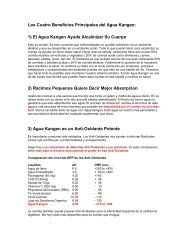ACID-ALKALINE BALANCE: ROLE IN CHRONIC ... - My Kangen Tools
ACID-ALKALINE BALANCE: ROLE IN CHRONIC ... - My Kangen Tools
ACID-ALKALINE BALANCE: ROLE IN CHRONIC ... - My Kangen Tools
You also want an ePaper? Increase the reach of your titles
YUMPU automatically turns print PDFs into web optimized ePapers that Google loves.
342 Y.-R. Huang et al. / Food Control 19 (2008) 329–345<br />
Table 5 (continued)<br />
Materials Immersion condition Indicator Effectiveness EO water property Ref.<br />
pH ORP (mV) Free chlorine (mg/L) Temperature (°C)<br />
5 min EO Listeria monocytogenes +++ 2.6 1125 40 23 Liu and Su<br />
(2006b)<br />
Natural rubber latex glove containing seafood<br />
residue<br />
Natural latex glove containing seafood residue 5 min EO Listeria monocytogenes ++ 2.6 1125 40 23 Liu and Su<br />
(2006b)<br />
Nitrile containing seafood residue 5 min EO Listeria monocytogenes ++ 2.6 1125 40 23 Liu and Su<br />
(2006b)<br />
Latex (disposable) containing seafood residue 5 min EO Listeria monocytogenes +++ 2.6 1125 40 23 Liu and Su<br />
(2006b)<br />
Nitrile (disposable) containing seafood residue 5 min EO Listeria monocytogenes +++ 2.6 1125 40 23 Liu and Su<br />
(2006b)<br />
Above 5 clean food processing gloves 5 min EO Listeria monocytogenes ++++ 2.6 1125 40 23 Liu and Su<br />
(2006b)<br />
++++, bacterial reduction being more than 4 log CFU/ per unit; +++, bacterial reduction being between 2 and 4 CFU/ per unit; ++, bacterial reduction being between 1 and 2 CFU/ per unit;<br />
+, bacterial reduction being less than 1 log CFU/ per unit.<br />
50 mg/L) with 100 rpm agitation for 30 min has achieved<br />
reduction by 3 logCFU/g. Since pathogens were attached<br />
to a water-skin interfaces and further entrapped in folds,<br />
crevices and follicles, no viable cell of C. jejuni was recovered<br />
in EO water after treatment. Kim, Hung, and Russell<br />
(2005) recommended to spray-wash chicken with ER water<br />
before defeathering and evisceration to reduce the potential<br />
cross-contamination. However, combining immersion with<br />
spray-washing did not significantly improve the bactericidal<br />
effect of EO water as compared to the immersion-only<br />
treatment. Fabrizio et al. (2002) reported that spray-washing<br />
with EO water, ozone, 2% acetic acid (AA) or 10% trisodium<br />
phosphate (TSP) did not show any significant<br />
microbicidal effectiveness. However, spray-washing with<br />
ER water followed by immersion in EO water had a better<br />
effectiveness than spraying with AA and TSP followed by<br />
immersion in chlorine solution at the end of a 7-day refrigerated<br />
storage.<br />
Fabrizio and Cutter (2004) had recently examined the<br />
spray-washing with EO water for 15 s to disinfect pork bellies<br />
inoculated with feces containing L. monocytogenes,<br />
S. Typhimurium and Campylobacter coli. This study demonstrated<br />
that a 15-s spraying with EO water (pH of 2.4,<br />
ORP of 1160 mV and free chlorine of 50 mg/L) had the<br />
ability to reduce the populations of L. monocytogenes,<br />
S. Typhimurium and C. coli (1.23, 1.67 and 1.81, respectively)<br />
on the pork surfaces and inferred that longer contact<br />
times might strengthen the disinfection effectiveness. For<br />
sterilizing hides of cattle before slaughtering, Bosilevac,<br />
Shackelford, Brichta, and Koohmaraie (2005) reported<br />
that sequentially applied ER water and EO water containing<br />
70 mg/L free chlorine at 60 °C for a 10-s spraying could<br />
reduce aerobic bacteria counts by 3.5 logCFU/100 cm 2 and<br />
reduced Enterobacteriaceae counts by 4.3 logCFU/<br />
100 cm 2 . Recently, Fabrizio and Cutter (2005) dipped or<br />
sprayed frankfurters and ham inoculated with L. monocytogenes<br />
with EO water (pH of 2.3, ORP of 1150 mV and<br />
free chlorine of 45 mg/L) and/or ER water for 30 min.<br />
No significant difference (p < 0.05) between treatments on<br />
Hunter L*, a*, b* values for frankfurters and ham at the<br />
end of 7 days storage at 4 °C was found. The results indicated<br />
that EO water has no detrimental ‘‘bleaching’’ effects<br />
on the surface of tested read-to-eat meats.<br />
8.5. Use of EO water for seafood<br />
Using EO water for inactivating bacteria in raw seafood<br />
have been reported (Table 5). Ozer and Demirci (2006)<br />
found that treating raw salmon with EO water (pH of<br />
2.6, ORP of 1150 mV and free chlorine of 90 mg/L) at<br />
35 °C for 64 min resulted in a 1.07 logCFU/g (91.1%)<br />
and 1.12 logCFU/g (92.3%) reduction in E. coli O157:H7<br />
and L. monocytogenes, respectively. Recently, Liu and Su<br />
(2006) stated that gloves used in handling food for protection<br />
of the worker and seller could become a carrier of<br />
pathogens through the contact of raw materials or contaminated<br />
surfaces. However, applications of EO water follow-



